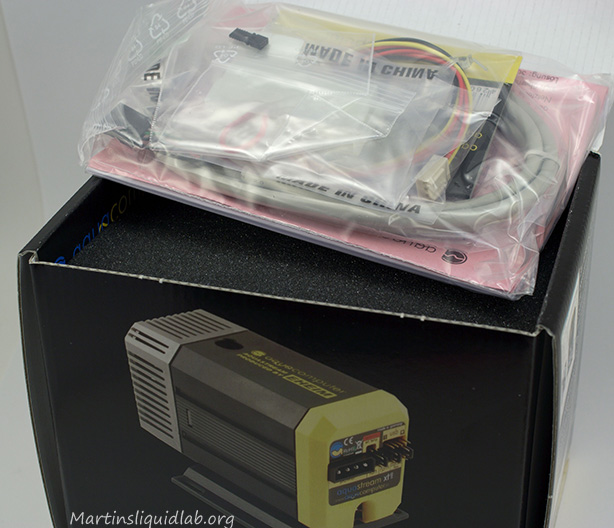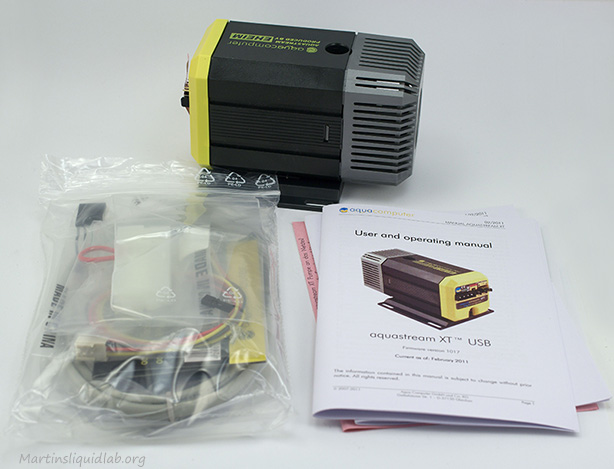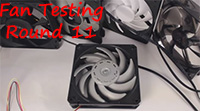Here we have another “Smart” pump for water cooling, and one that is built by Eheim and Aquacomputers, the aquastream XT. Not only does it pump, it’s the only pump capable of being manually or automatically controlled via software, monitor’s water temperature, and it can also control the speed of one 5W fan channel (or a poweradjust 2 for 25w). While there are a few smart pumps that can control pump speed, this is the only one I’m aware of that incorporates a full software suite and control of so much.
A special thanks goes out to Shoggy of Aqua Computers for sponsoring this pump!
He included it as part of the Aquareo 5 package I’ll be reviewing soon following the pump in flow meter.
Packaging
Who doesn’t like un-boxing new products? Perhaps it’s growing up celebrating Christmas, but to this day I still enjoy this and perhaps why I still like doing these reviews. Besides the normal surprise element, I think it’s also important that products are packaged well and accessories can make a difference. The Aquastream XT ultra comes in a nice 6″ x 6″ x 5″ color printed box with various bits printed on the exterior.

Below are the specs printed on the box:

The specs check out well, and I would take note of the “automatic frequency adjustment”, this is a rather unique feature of this pump that causes the pump to restart on occasion as it’s testing the restriction level and tuning the pump. This is intended to ensure the pump operates at the best operating point which should ensure the pump can’t overheat and also turns up the speed when restriction is present.
And there are multiple versions of the pump, and those differences are fairly well outlined below. The model I’m reviewing here is the higher end “Ultra” flavor.
 The bottom five features are what really makes this pump interesting for me, since it does much more than pump. These features basically makes it an advance fan controller. You can hook up a flow meter, fans, external temperature sensor, and monitor/control it all including the internal water temp sensor using software. That’s considerably more “Smart” that pretty much any other pump I’ve used.
The bottom five features are what really makes this pump interesting for me, since it does much more than pump. These features basically makes it an advance fan controller. You can hook up a flow meter, fans, external temperature sensor, and monitor/control it all including the internal water temp sensor using software. That’s considerably more “Smart” that pretty much any other pump I’ve used.
Upon opening the box presents:

Pulling out the soft foam casing reveals the pump:
 I’m impressed by the foam protection here, that’s probably the best protection I’ve seen on any pump reviewed before.
I’m impressed by the foam protection here, that’s probably the best protection I’ve seen on any pump reviewed before.
Pulling it all out gives the following contents:

 The USB cable on the upper left, the RPM monitor cable upper right, PSU jumper lower right, and aeration jumper lower left.
The USB cable on the upper left, the RPM monitor cable upper right, PSU jumper lower right, and aeration jumper lower left.
There were several bits of paper, most of which are written in other languages, but there is an English manual that’s fairly detailed and nicely done.
So that’s the package, but before going too far you should know that you need this accessory. It’s a shame it’s not part of the pump box package as you pretty much need this for standard water cooling use where G1/4 is the standard. This adapter kit is necessary to convert the larger inlet and smaller outlet ports to standard g1/4 water cooling fitting size. AC sent me one, but don’t forget it; it’s a must-have extra.

Impression of the packaging was very good although I think the adapter kit should be a standard part of the package. The pump was extremely well protected and the overall presentation was done fairly well. The user manual was also done well and a welcome and somewhat necessary addition since this pump does soo much more than just pump.







 The bottom five features are what really makes this pump interesting for me, since it does much more than pump. These features basically makes it an advance fan controller. You can hook up a flow meter, fans, external temperature sensor, and monitor/control it all including the internal water temp sensor using software. That’s considerably more “Smart” that pretty much any other pump I’ve used.
The bottom five features are what really makes this pump interesting for me, since it does much more than pump. These features basically makes it an advance fan controller. You can hook up a flow meter, fans, external temperature sensor, and monitor/control it all including the internal water temp sensor using software. That’s considerably more “Smart” that pretty much any other pump I’ve used.
 I’m impressed by the foam protection here, that’s probably the best protection I’ve seen on any pump reviewed before.
I’m impressed by the foam protection here, that’s probably the best protection I’ve seen on any pump reviewed before.
 The USB cable on the upper left, the RPM monitor cable upper right, PSU jumper lower right, and aeration jumper lower left.
The USB cable on the upper left, the RPM monitor cable upper right, PSU jumper lower right, and aeration jumper lower left.

 It comes in a longer brown box as shown here with solid foam protection along the sides
It comes in a longer brown box as shown here with solid foam protection along the sides No major assembly required, ready for single pump right out of the box
No major assembly required, ready for single pump right out of the box






You must be logged in to post a comment.